News Archive

Adlershof Journal March/April 2024
This is the future: Quantum computing, machine learning and cybersecurity:
In conversation with Johannes Klick, who puts hackers out of business // KURO – A new start-up is breathing life into the construction industry // Valuable breaks: Adlershof’s green canteen …

NanoMECHs project at HU Berlin receives 1.5 million euros in funding
Research group at the Department of Chemistry wants to develop molecular machines that produce new materials:
Three young researchers at Humboldt-Universität (HU) have been accepted for Emmy Noether funding from the German Research Foundation (DFG). Dr Michael Kathan, who conducts research in the field of synthetic chemistry…

Helmholtz Zentrum Berlin is a bicycle-friendly employer
With the certificate, the research institute aims to be more attractive to employees and improve its carbon footprint:
Since 2017, the German Cyclists' Federation (ADFC) has been awarding the EU-wide "Bicycle-Friendly Employer" certification. The Helmholtz-Zentrum Berlin has now been awarded the coveted silver seal. With this, the HZB…

New instrument for optoelectronics records 14 parameters in one go
HZB physicist develops measurement process for characterising semiconductors that saves valuable time:
An HZB physicist has developed a new method for the comprehensive characterisation of semiconductors in a single measurement. The “Constant Light-Induced Magneto-Transport (CLIMAT)” is based on the Hall effect and…

Sodium-ion batteries: How doping works
Researchers from HZB and Humboldt-Universität discover two competing mechanisms that determine the stability of cathodes:
Sodium-ion batteries still have a number of weaknesses that could be remedied by optimising the battery materials. One possibility is to dope the cathode material with foreign elements. A team from HZB and…

As easy as counting to ten – a new rule for catalysts’ design
Scientists from three British universities and Humboldt-Universität zu Berlin (HU) discover new rule for catalyst design:
A collaborative team from three British universities and from Humboldt-Universität have discovered a very simple rule to design single-atom alloy catalysts for chemical reactions. The ‘ten electron rule’ helps…
Funding of basic research for green energy of the future
Establishing a research group between Seoul and Berlin:
Professor Wonwoo Nam is an Einstein Visiting Fellow of the Einstein Foundation Berlin and has received the Alexander von Humboldt Research Award, which is linked to a research stay at Humboldt Universität zu Berlin…

Reconstruction of atomic electron densities
PTB researchers have further developed the procedure and the mathematical methods for visualising the spatial distribution of electrons in the atom:
Reconstructing the spatial electron density of atomic systems not only provides new insights into quantum mechanics, but also advances in areas such as material science and functional surfaces. In the photoelectric…

Molecular orbitals determine stability
Team at HZB has elucidated the influence of the electronic structure on the stability of fumarate, maleate and succinate dianions:
Carboxylic acid dianions (fumarate, maleate and succinate) play a role in coordination chemistry and to some extent also in the biochemistry of body cells. An HZB team at BESSY II has now analysed their electronic…

ESA approves Venus EnVision mission
DLR is contributing a multispectral camera to map the mineralogy and perform measurements in the venusian atmosphere:
Venus, Earth's inner neighbouring planet, is a mysterious celestial body. Almost the same size as Earth, with only a slightly smaller mass and largely made up of the same materials as Earth, Venus has developed in a…

DLR’s Mars camera – 20 years of operations
The first image was transmitted to Earth on 10 January 2004:
An extraordinary success story, and a long-lasting one at that. For 20 years now, DLR's High Resolution Stereo Camera (HRSC) on board the European Space Agency (ESA) Mars Express orbiter has been providing the science…

Ultrafast excitations in correlated systems
Team of researchers presented new ideas for ultrafast multi-dimensional spectroscopy of strongly correlated solids:
An international team of researchers from the European XFEL together with colleagues from the Max Born Institute in Berlin, Universities of Berlin and Hamburg, The University of Tokyo, the Japanese National Institute…
Funding required for practice-oriented research into electromobility
Broad alliance from research and industry criticises planned cuts in federal funding by the government:
A broad alliance from research and industry is calling on the German government to provide federal funding for application-oriented research into electromobility in the 2024 budget and beyond. In an open letter, the…

Local variations in the atomic structure of High-Entropy Alloys
HZB study provided deeper insights into alloy materials at the atomic scale:
High-entropy alloys can withstand extreme heat and stress, making them suitable for a variety of specific applications. A new study at the X-ray synchrotron radiation source BESSY II has now provided deeper insights…

In conversation with Beate Schultz-Zehden
As vice-rector at the bbw University of Applied Sciences, she is responsible for making teaching future-proof:
“This is exactly where we belong,” is what the management of bbw Hochschule - University of Applied Sciences exclaimed when it moved the Adlershof Technology Park in April 2023. Since then, the roughly 1,200 students…
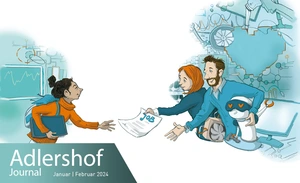
Our heart beats for high-tech
The opinion of Katrin Robeck, Managing Director of B.I.G. Corporate Services, on the topic of talent:
The ‘talent issue’: Is it as threatening as it is sometimes portrayed? As a medium-sized company with a very high demand for high-skilled workers from the STEM sector, we take the issue very seriously. However, at the…
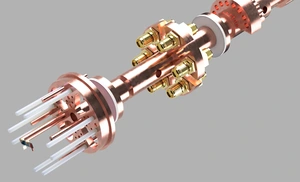
Higher measurement accuracy opens new window to the quantum world
HZB team developed new measurement method for temperature differences in the sub-millikelvin range:
A team at HZB has developed a new measurement method that, for the first time, accurately detects tiny temperature differences in the range of 100 microkelvin in the thermal Hall effect. Previously, these temperature…
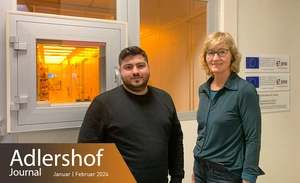
A career change into the future
The proANH e.V. association is securing demands for skilled staff in microtechnology by offering advanced vocational training to become an electronics manufacturing specialist:
He was looking for a future-proof career opportunity, says Onur Sahin. The 30-year-old was looking to “take a new path.” It was a fabulous stroke of luck that it led him straight to the cleanrooms at…
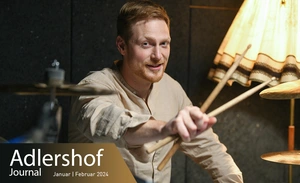
The radiation man
Jan Ruschel investigates short-wave UV light sources in Adlershof:
He could have done something completely different. “Way back in the day, I thought I might become an artist,” says Jan Ruschel. Quite a few brows were furrowed at his grammar school in Berlin when he chose a very…
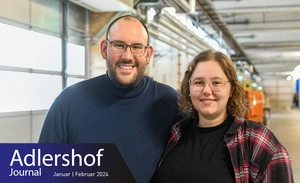
Television up close
The guided tours of the studios in Berlin Adlershof attract both Berliners and non-Berliners:
Berlin is not only the country’s capital but also a television hub. Many of the studios in Berlin Adlershof are up to 2,400 square metres large and home to TV mainstays like ‘Verstehen Sie Spaß?’ and ‘Klein gegen…